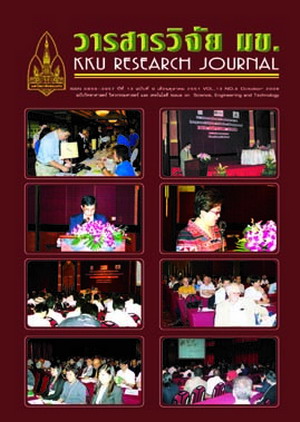Contamination of heavy metals in sediment and mollusks collected form Bueng Jode reservoir, Khon Kaen province
Main Article Content
Abstract
This study was aimed to use some freshwater mollusk species as passive biomonitor and bioaccumulator for some heavy metals in a lenthic ecosystem so-called Bueng Jode Reservoir. The study was conducted between August 2006 and April 2007. Sediment and mollusk samples were collected at each station along the three seasons. These samples were analyzed for Cd, Cu, Zn, Pb and Hg. Bioaccumulation of heavy metals was examined from two mollusk species (Filopaludina martensi and Pomacea canaliculata), which were collected from 5 sampling stations. Heavy metal concentrations were directly analyzed by inductively coupled plasma - optical emission spectrometry (ICP-OES) technique. High concentration of heavy metals in mollusks was detected in rainy season. In mollusk tissues, concentrations of Zn were higher than Cu and Pb. Furthermore, the concentrations of Zn in Filopaludina martensi were higher than in that Pomacea canaliculata during study period. In rainy season, the average concentration of Zn was higher than that of Cu, Pb, Cd and Hg respectively. Whilst in cool and summer seasons, the average concentrations of Zn in sediments were higher than Pb and Cu respectively. Statistical analysis (one-way ANOVA) indicated the different concentrations of metals in mollusks and sediments. The comparative study showed that the accumulation of heavy metals in mollusk tissues were significantly higher than in sediment samples.
Article Details
How to Cite
Neeratanaphan, L., & Phalaraksh, C. (2017). Contamination of heavy metals in sediment and mollusks collected form Bueng Jode reservoir, Khon Kaen province. Asia-Pacific Journal of Science and Technology, 13(9), 1058–1064. retrieved from https://so01.tci-thaijo.org/index.php/APST/article/view/83532
Section
Research Articles


